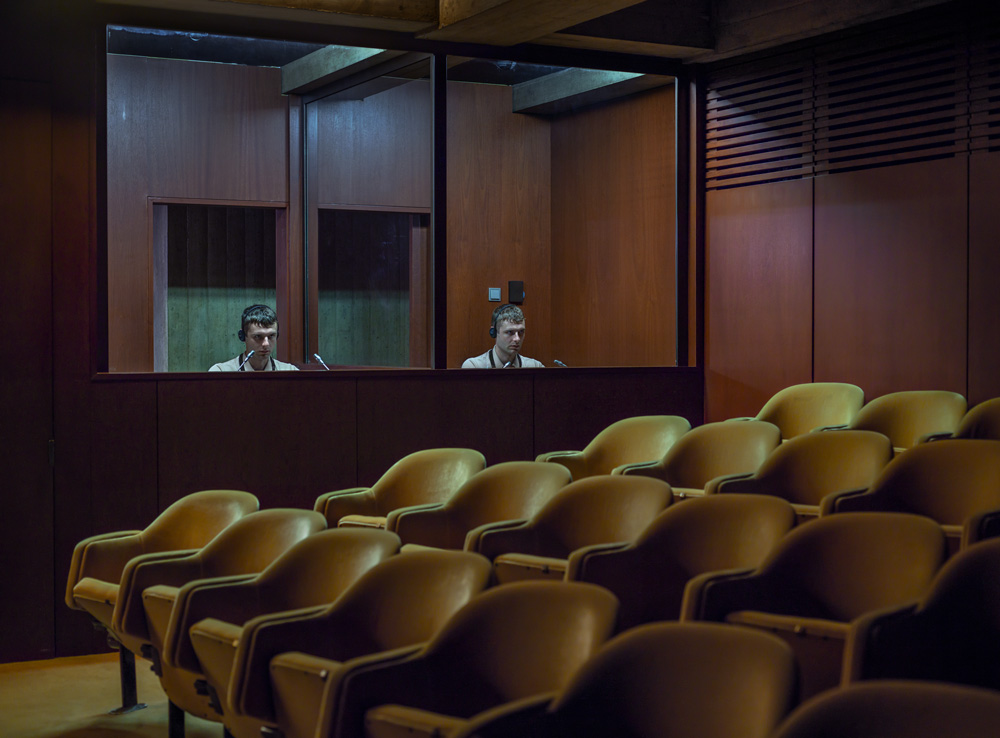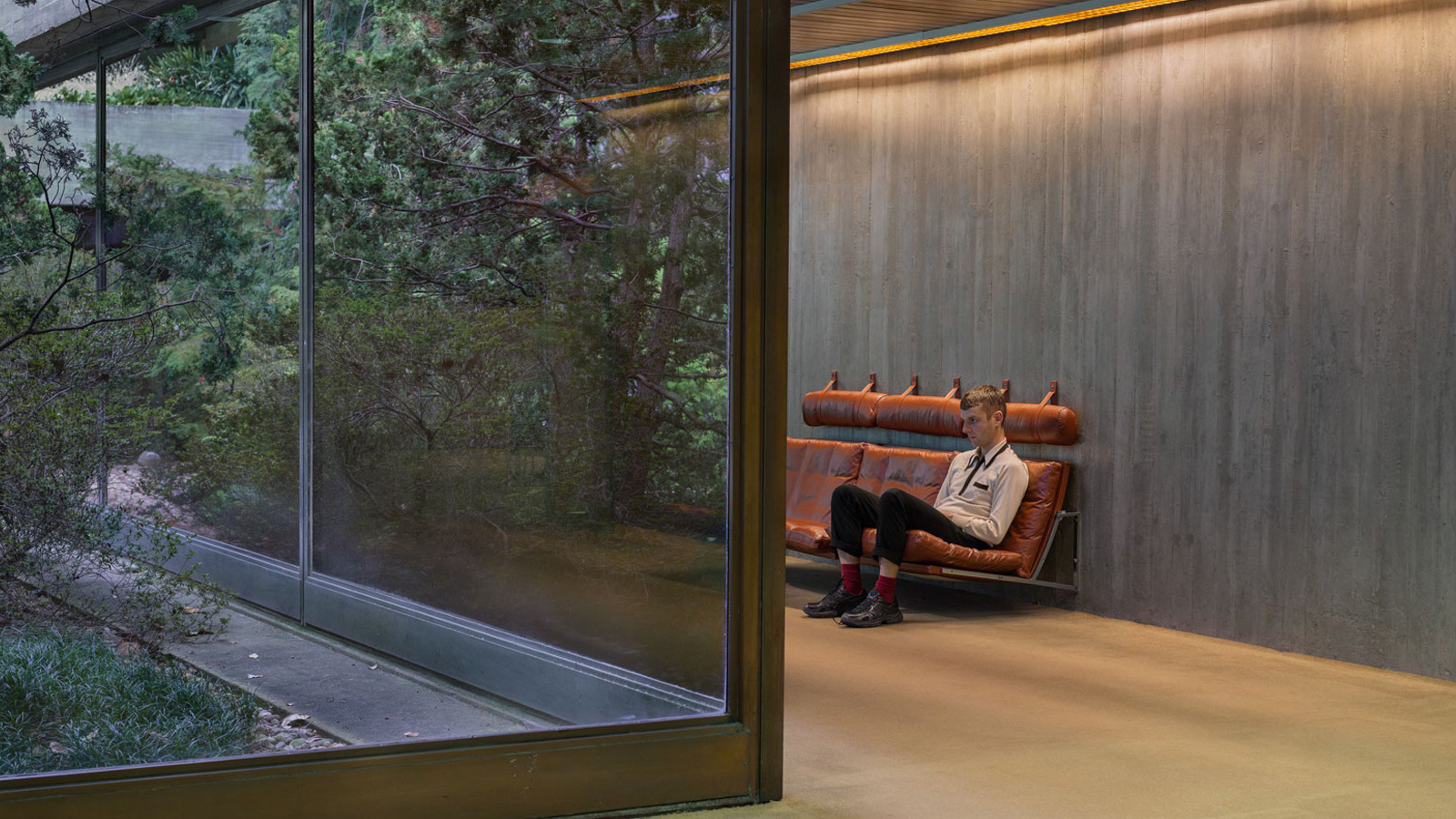‘For Laura’ by Jaime Welsh in the CAM Collection
For Jaime Welsh (Lisbon, 1994), his circle of friends and the lives of the people he meets and admires play an important role in the composition of his series, and ‘For Laura’ is no exception.
Laura, to whom the series is dedicated, is the name of the mother of a great friend and artist – Kevin Brennan – who also happens to be the protagonist of this group of images. What prevails in the series, however, is not an intention towards friendship or Welsh’s admiration for Laura, but rather his notions of attributing a representational function to a character, as though they were part of a theatre play or film.
The first feeling we have, when we look at the two images from Jaime Welsh’s ‘For Laura’ series[1] that are now part of the CAM Collection, could be one of emptiness. Of something vague and inconclusive. The fixed gaze that loses itself beyond the glass separating the figure from an interior garden, or the emptiness of an auditorium with no public to hear what might be interpreted in the sound booth.
Then, with a second glance, we might think about the theme of the double, or duplicity. This is more evident in the duplication of the character in ‘For Laura (velvet)’, sitting in the interpreting booth, but also in the possible reflection of the figure in the glass separating him from the garden, in ‘For Laura (slice)’.
Finally, perhaps with a more attentive look, we perceive a psychological suggestion of alienation, of some kind of contained anxiety, isolation, and an inability to communicate.
All these ‘layers’ that can be read in the images – emptiness, duplication, alienation, isolation, lack of communication – are important in characterising a figure who can in some way convey a metaphorical view of the adverse effect of the communication society of the 21st century, exacerbated by social media, through which we actually see increasing symptoms of isolation, anxiety, distress, frustration, split personality and inner emptiness.

It is also worth noting the significance of the mediating role of the glass, at which the characters stare directly in both images. Glass whose transparency appears to be amplified by that stare fixed on a point beyond it but which, meanwhile, is very much there and limits the person’s access or physical contact with what they see. The presence of this glass, with a sense of ‘seeing beyond’ without being able to get there, is obviously a desired effect in Welsh’s careful staging, which further reinforces the feeling of desire, of impossibility, of separation, of the inability to come out of oneself, even in the duplication of the figure in ‘For Laura (velvet)’, still shut away in the interpreting booth.
In Welsh’s images, we note a disparity between the economy of the staging (stripped back and simple) and the complex emotional meaning these pictures can express. They are images that, to simplify Heidegger’s phrase, position themselves as ‘standing-reserve,’[2] that is to say, they make possible more than what they show – an effect amplified by the static poses in both images.
A close observation of Welsh’s images, from this and other series by the artist, indicates a work method that is closer to that of a creator of characters or a stage director than to a photographer, in the usual sense of the term.
In fact, Welsh does not regard himself as a photographer and his training in painting, before attending a master’s course in London (MFA Fine Art at Goldsmiths, University of London), goes some way to explaining the fact that his references are indeed closer to painting (he is a regular visitor to the National Gallery), film (Pasolini, Antonioni, Michael Haneke, Yórgos Lánthimos) and architecture (Berthold Lubetkin, Ernő Goldfinger, Rolf Engströmer) than to photography itself. Repérage, or location scouting, with particular attention to architecture, preparatory drawings and the careful manipulation of the image at the post-production stage are all part of his work process, to which he adds the drama of a ‘cinematic’ photograph, by adopting codes close to and influenced by film, in the evocation of environments relevant to the narratives condensed in the images that make up his series.
[1] The series is completed in four images: ‘For Laura (slice)’, ‘For Laura (velvet)’, ‘For Laura (double)’ and ‘For Laura (expanded Calais)’, all from 2021. The subheadings, slice, velvet, double and expanded Calais are functional, allowing us to distinguish between each image in the series (velvet for example, refers to the velvety appearance of the fabric on the auditorium chairs).
[2] Heidegger, Martin (1977). ‘The Question Concerning Technology and Other Essays’, Transl. and with an Introduction by William Lovit, New York and London: Garland Publishing, Inc., p.17.

